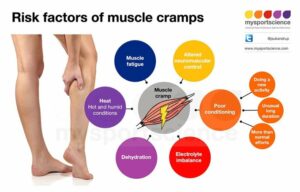Cramps are a common and often painful experience that many people have encountered at some point in their lives. Our physiotherapy clients often report these symptoms. The cramp can occur in various parts of the body, including the legs, feet, and abdomen, and are characterized by sudden, involuntary muscle contractions. While cramps are usually harmless and temporary, they can be quite uncomfortable and disruptive. The area may remain sore for hours or days. studies have attempted to shed light on the prevalence of cramping, with one survey indicating that 67% of triathletes reported experiencing some level of cramping, and 4% reported severe cramping. In this blog post, we will explore the various causes of cramps, shedding light on the factors that may contribute to their occurrence.
When we consider cramps and the causes, we consider three broad categories; exercise induced muscle cramps, symptomatic muscle cramps or idiopathic nocturnal muscle cramps. There is almost always a venn diagram of overlap between some of the contributing factors.
Exercise -Induced Muscle Cramps: perhaps doing a new activity, or an unusually long activity or an unusually strenuous activity. One of the primary causes of cramps is an electrolyte imbalance. Electrolytes, such as potassium, magnesium, and calcium, play a crucial role in muscle function. When the levels of these electrolytes become imbalanced, it can lead to muscle cramping. Dehydration is another common trigger for cramps. When the body lacks an adequate amount of fluids, it can affect muscle function and increase the likelihood of experiencing cramps. Exercise-related cramps are also prevalent, particularly during intense or prolonged physical activity. Muscle fatigue, which occurs when muscles are overworked or tired, can lead to cramping as well. Additionally, heat-related factors, such as exercising in hot weather or being in a hot environment for an extended period, can contribute to the onset of cramps. We all watched the England football team consume pickle juice during the Euros tournament in June 2024 to reduce the risk of cramp.
The second most likely contributing factor is altered neuromuscular input. Studying the nervous system’s role in cramping has been challenging, but experiments using electrical muscle stimulation have provided valuable insights. It has been observed that athletes prone to cramps require less electrical stimulation to trigger cramps, supporting the idea of a nerve-related mechanism in the occurrence of cramps. With the above factors, it best to see one of our team for a physiotherapy assessment. Click here to Book now
Intoxication from alcohol or drugs can also result in muscle cramping. Certain medications, such as diuretics or statins, may have cramping as a potential side effect. Furthermore, neurological conditions, such as pinched nerves or neuropathy, can cause cramps due to their impact on the communication between the nerves and muscles. Systemic conditions, including thyroid disorders or diabetes, being overweight or being pregnancy are known to be associated with an increased risk of experiencing cramps. In some cases, individuals may suffer from cramps without any identifiable cause, which can be frustrating and challenging to address.
Nighttime cramps can be an enigma to treat. The cause is less clearly defined and so too is the treatment. The risk of experiencing cramps increases with age, particularly so when combined with other medical conditions such as kidney impairment and spinal conditions. GPs will sometimes prescribe medication to reduce the frequency and severity once all other factor have been addressed.
It is essential to note that while cramps are often benign and self-limiting, they can sometimes be indicative of an underlying medical issue that requires attention. If you experience frequent or severe cramping, it is advisable to consult your GP or physiotherapist for an evaluation and appropriate management.
In conclusion, cramps can stem from a variety of factors, ranging from electrolyte imbalances and dehydration to exercise-related strain, neurological conditions, and systemic disorders. Understanding the potential causes of cramps can help individuals take proactive measures to prevent them or seek appropriate treatment when necessary. As with any health concern, maintaining a balanced active lifestyle, staying hydrated, and seeking medical advice when needed are crucial steps in managing and addressing cramps effectively.
Thanks to @Jeukenndrup for this pictorial representation.
